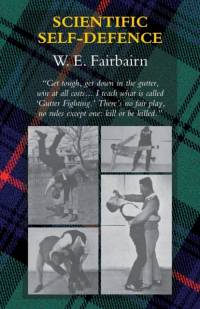Om Scientific Self-Defence
The Fairbairn system was based on his training and knowledge in boxing, wrestling, savate, jujutsu, judo and fights he was also involved in during his police work. Fairbairn began to develop his own system of hand-to-hand combat, initially referring to it as 'Defendu'. It was designed to be simple to learn and to provide effective results. Fairbairn published his book, 'Defendu', in 1926 (reprinted as 'Scientific Self Defence' in 1931), illustrating this method and it is here that the term 'Defendu' first appeared. This confused early readers of the book, who assumed that the techniques within it had been based mainly in the Eastern martial arts that Fairbairn had learned.
Fairbairn was called upon by the British to help train Allied troops in World War II. Fairbairn and others expanded on this system to create the Close Quarters Combat system that was then taught to the troops. This system was built on Defendu, but modified for military applications, rather than police and riot control.
The original Defendu was oriented towards self-defence and restraint, while the Close Quarters Combat system concentrated on rapid disabling of an opponent, with potentially lethal force. The militarised version of Defendu is described in the military manual 'All-in Fighting 1942', used as a supplement during WW2 CQC training. This book was later published in a civilian edition, missing the chapters on bayonet fighting and rifle sighting, under the name 'Get Tough! How to Win in Hand-to-Hand Fighting. As Taught to the British Commandos and the U.S. Armed Forces'. Fairbairn's CQC system is also described in Rex Applegate's book 'Kill or Get Killed'.
Together with Eric A. Sykes, Fairbairn developed innovative pistol shooting techniques and handgun specifications for the Shanghai Municipal Police which were later disseminated through their book 'Shooting to Live with the One-Hand Gun', along with various other police innovations such as riot batons, armoured vests and other equipment.
He is perhaps best known for designing the famous Fairbairn-Sykes fighting knife, or 'Commando' knife, a stiletto-style fighting dagger used by British Special Forces in the Second World War, and featured in his textbook 'Scientific Self-Defence'. Fairbairn also designed the lesser-known Smatchet, and collaborated on the design of several other combat knife designs.
Publications:
Defendu
Scientific Self-Defence
All-In Fighting
Get Tough
Hands Off! (Self Defence for Women and Girls)
Shooting to Live
All of Fairbairn's works are published and available from The Naval & Military Press.
Visa mer

